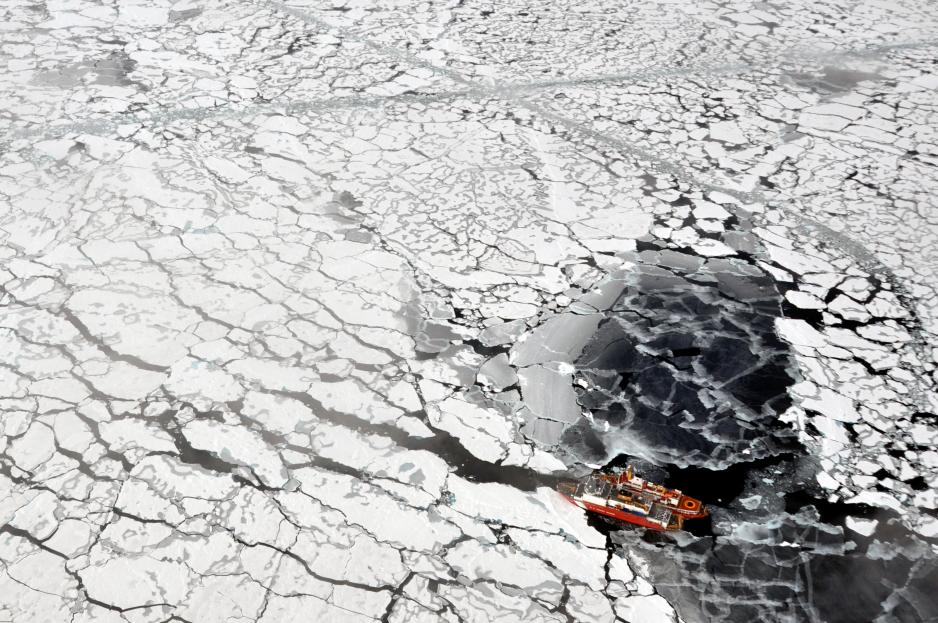Blacklisting Black Carbon: Heavy Fuels and Shipping in the High North

As the ice continues to melt at the top of the world, climate change is altering more than global weather patterns. The opening up of Arctic waters as summer sea ice continues a thirty-year retreat trend holds the opportunity to cut a third off distances between North-West Europe and the Far East.
With the UN Panel on climate change predicting a nearly ice-free Arctic Ocean in September before 2050, there is an expectation that the patterns of world trade are poised to go polar.
But with more commercial use of circumpolar shipping lanes comes more risk of fuel pollution of and spillage into the Arctic’s fragile ecosystem. This week in Stockholm, the Arctic Council Protection of the Marine Environment Working Group will meet to discuss, among other issues, the regulation and potential ban of heavy fuel oil.
"Impractical, if not impossible"
The decision to include discussions on heavy fuel oil this week comes after an open letter was published on the topic by 15 international NGOs (non-governmental organizations, editorial remark), including WWF, NDRC, and Friends of the Earth.
In their letter addressed to Ambassador David Balton, US State Department diplomat and current chair of the Senior Arctic Officials group, NGO leaders voiced their concern that heavy fuel oil would be “impractical, if not impossible” to clean up in the event of a spill. “We believe that measures are desperately needed to reduce the environmental impacts from Arctic shipping, and that a logical place to focus attention is vessel fuel quality.
The letter goes on to note that the effects of emissions created by burning heavy fuel oils further exacerbate public health issues and climate change in the High North.
This debate over heavy fuel oil use in the Arctic is not new. Since the 1960s, heavy fuel oil has dominated the international shipping industry due to its low costs. But low costs do not mirror its impact on the environment and human health. The sulfur content of heavy fuels can be up to 35,000 parts per million, contributing heavily to acid rain and respiratory diseases. In port and near-route communities, emissions of particulate matter, directly tied to the sulfur content, lead to further health issues. In 2012, one estimate contributes 87,000 premature deaths worldwide to the emissions of maritime shipping.
Heavy fuel oil - the top threat
In the Arctic Council’s 2009 marine shipping assessment, researchers identified a spill of heavy fuel oil as the top threat posed by shipping to the Arctic environment. The two main concerns are heavy oil spills and black carbon. Rather an evaporating like other petroleum products, heavy fuel oil has a propensity to combine with seawater and expand in volume, sticking to anything it comes into contact with.
A recent spill in Russia, as only one example, led to the death of hundreds of seabirds. In business as normal use, ships fueled by heavy oils produce black carbon, a fine soot that falls on snow and ice, absorbing more UV sun rays and quickening melting.
While cleaning up black carbon has been identified as an easy and quick way to slow the retreat of Arctic sea ice, a gap has formed between research and political action.
Countries like Russia that have large, heavy oil-fueled merchant fleets have pressured regional and international bodies like the International Marine Organization to stall on regulating heavy fuels in the North. Perhaps the most prominent result of anti-ban lobbying efforts was the 2015 approval of the Polar Code, a set of UN regulations governing traffic in the Arctic, without including limitations on heavy fuel use.
Banned in the Antarctic
But there is hope. Heavy fuels have been banned in the Antarctic since 2010, setting a precedent for their elimination around Earth’s other pole. And in previous meetings, Mr. Bolton has advocated for the elimination of heavy fuels in the Arctic, citing their dangers to animals, human, and ocean health. Eliminating black carbon was a top priority for the Canadian Chairmanship and continues on today as a top priority for the US leadership over the next two years.
Last April in Iqaluit, countries committed themselves to limiting their emissions of black carbon. Though it is not legally binding, these efforts lay the foundation for moving forward on heavy fuel oils this week in Stockholm.
Aiming to limit - or ban
The Protection of the Marine Environment Working Group’s mandate is to address policy and non-emergency pollution prevention and control measures in the Arctic. As commercial use of Arctic shipping lanes increases, the threats posed by the fuel to the Arctic Ocean continue to move further into the purview of the Working Group’s mission.
The aim of Working Group discussions this week to limit or ban the use of heavy fuel oils is not meant to stop polar commerce. Rather, the goal of these talks is to convert cargo ships that ply circumpolar waters to run on less harmful, lower-sulfur fuels like Marine Gas Oil or Marine Diesel Oil.
Such a fuel shift could not only result in a healthier Arctic environment and population, but also encourage technological advances in shipping efficiency in the decades to come.
